Operation of modern household and computer equipment without grounding is fraught with its failure. In a significant part of our country, especially in rural areas, there are old-style power transmission systems. They do not provide for the presence of protective grounding or they are in such a state that they simply do not meet the requirements of electrical safety. Therefore, the owners have to do the grounding of a private house or cottage themselves.
What does it give
Protective grounding is necessary to ensure electrical safety in the house. Properly performed, the appearance of a leakage current leads to the immediate operation of the RCD (damage to the electrical insulation or when touching live parts). This is the main and main task of this system.
The second function of grounding is to ensure the normal operation of electrical equipment. For some electrical appliances, the presence of a protective wire in the socket (if any) is not enough. A direct connection to the ground bus is required. For this, there are usually special clips on the case. If we talk about household appliances, then this is a microwave oven, oven and washing machine.
The main task of grounding is to ensure the electrical safety of a frequent home.
Few people know, but a microwave oven without a direct connection to the "ground" during operation can significantly emit radiation, receiving a radiation level can be life-threatening. In some models, a special terminal can be seen on the back wall, although the instructions usually contain only one phrase: “grounding is required” without specifying exactly how it is desirable to do it.
When wet hands touch the body of the washing machine, a tingling sensation is often felt. It's harmless, but annoying. You can get rid of it by connecting the "ground" directly to the case. In the case of the oven, the situation is similar. Even if it doesn't 'sting', a direct connection is safer, as the wiring inside the unit is subject to very harsh conditions.
With computers, the situation is even more interesting. By directly connecting the "ground" wire to the case, you can increase the speed of the Internet several times and minimize the number of "freezes". It's so simple because of the presence of a direct connection to the ground bus.
Do I need grounding in the country or in a wooden house
In holiday villages, it is necessary to make grounding. Especially if the house is built of combustible material - wood or frame. It's about thunderstorms. There are a lot of elements that attract lightning in summer cottages. These are wells, wells, pipelines lying on the surface or buried to a minimum depth. All these objects attract lightning.

If there is no lightning rod and grounding, a lightning strike is almost tantamount to a fire. There is no fire station nearby, so the fire will spread very quickly. Therefore, together with grounding, also make a lightning rod - at least a couple of meter-long rods attached to the ridge and connected with a steel wire to grounding.
Grounding systems of a private house
There are six systems in total, but in individual developments, mainly only two are used: TN-S-C and TT. In recent years, the TN-S-C system has been recommended. In this scheme, the neutral at the substation is solidly grounded, and the equipment has direct contact with the ground. To the consumer, earth (PE) and neutral / zero (N) are conducted by one conductor (PEN), and at the entrance to the house it is again divided into two separate ones.
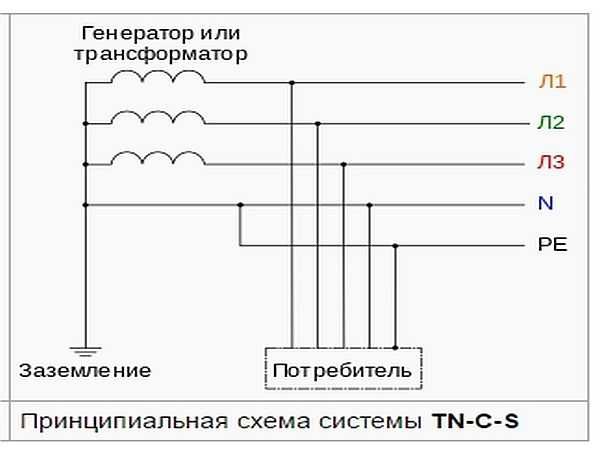
With such a system, a sufficient degree of protection is provided by automatic devices (RCDs are not required). The disadvantage is that if the PEN wire burns out or is damaged in the area between the house and the substation, a phase voltage appears on the earth bus in the house, which is not turned off by anything. Therefore, the PUE imposes strict requirements on such a line: there must be mandatory mechanical protection of the PEN wire, as well as periodic backup grounding on poles every 200 m or 100 m.
However, many transmission lines in rural areas do not meet these conditions. In this case, the TT system is recommended. Also, this scheme should be used in free-standing open outbuildings with an earthen floor. They have a risk of touching the ground and the ground at the same time, which can be dangerous in a TN-S-C system.
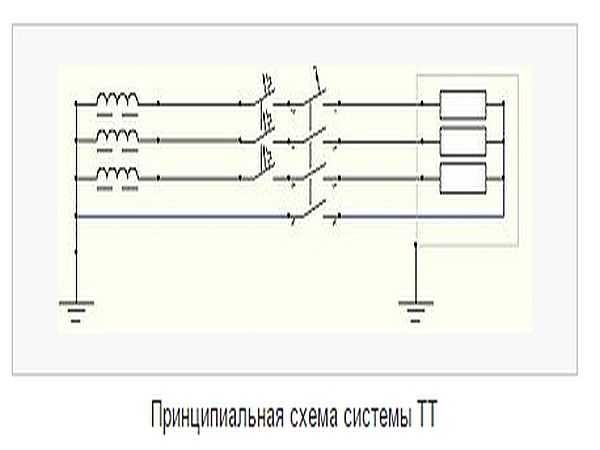
The difference is that the "ground" wire to the shield comes from an individual ground loop, and not from a transformer substation, as in the previous diagram. Such a system is resistant to damage to the protective wire, but requires the mandatory installation of an RCD. Without them, there is no protection against electric shock. Therefore, the PUE defines it only as a backup if the existing line does not meet the requirements of the TN-S-C system.
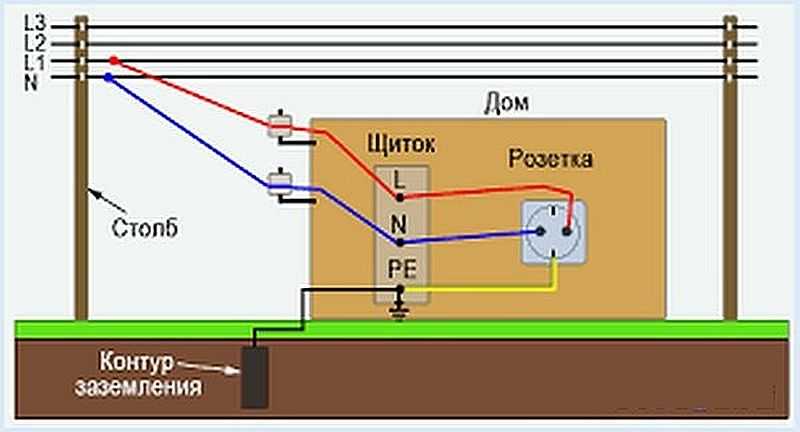
Grounding device of a private house
Some older transmission lines do not have a protective earth at all. All of them should change, but when this will happen is an open question. If you have just such a case, you need to make a separate circuit. There are two options - to make grounding in a private house or in the country on your own, with your own hands, or to entrust the execution of the campaign. Campaign services are expensive, but there is an important plus: if during operation there are problems caused by improper functioning of the grounding system, the company that performed the installation will compensate for the damage (should be written in the contract, read carefully). In the case of self-execution, everything is on you.
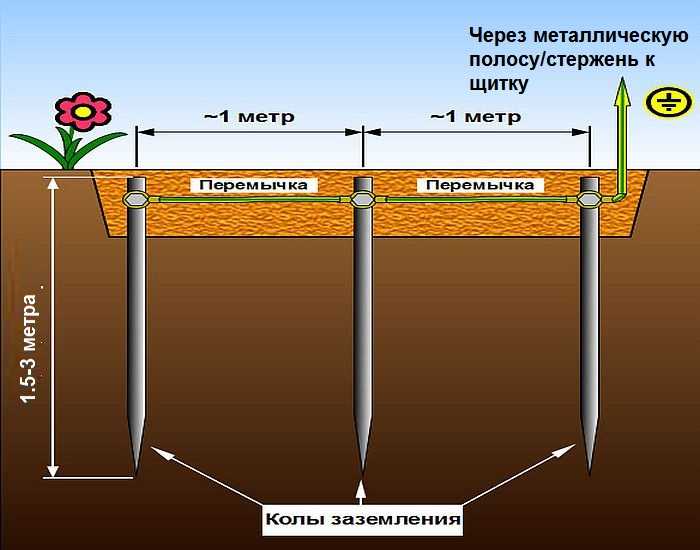
The grounding system of a private house consists of:
- grounding pins,
- metal strips that combine them into one system;
- lines from the ground loop to .
What to make ground electrodes
As pins, you can use a metal rod with a diameter of 16 mm or more. Moreover, it is impossible to take reinforcement: its surface is hardened, which changes the current distribution. Also, the red-hot layer in the ground is destroyed faster. The second option is a metal corner with 50 mm shelves. These materials are good because they can be hammered into soft ground with a sledgehammer. To make this easier to do, one end is pointed, and a platform is welded to the second, which is easier to hit.

Sometimes metal pipes are used, one edge of which is flattened (welded) into a cone. Holes are drilled in their lower part (about half a meter from the edge). When the soil dries out, the distribution of the leakage current deteriorates significantly, and such rods can be filled with saline, restoring the operation of the ground. The disadvantage of this method is that you have to dig / drill wells under each rod - you won’t be able to hammer them with a sledgehammer to the desired depth.
Depth of driving pins
Ground rods should go into the ground at least 60-100 cm below the freezing depth. In regions with dry summers, it is desirable that the rods be at least partially in moist soil. Therefore, mainly corners or a rod 2-3 m long are used. Such dimensions provide a sufficient area of \u200b\u200bcontact with the ground, which creates normal conditions for dissipating leakage currents.
What Not to Do
The job of a protective earth is to dissipate leakage currents over a large area. This happens due to the tight contact of metal ground electrodes - pins and strips - with the ground. That's why grounding elements are never painted. This greatly reduces the conductance between the metal and the ground, the protection becomes ineffective. Corrosion at welding points can be prevented with anti-corrosion compounds, but not with paint.
The second important point: grounding should have low resistance, and good contact is very important for this. It is provided by welding. All joints are welded, and the quality of the seam must be high, without cracks, cavities and other defects. Once again, pay attention: grounding in a private house cannot be done on threaded connections. Over time, the metal oxidizes, breaks down, the resistance increases many times, the protection deteriorates or does not work at all.
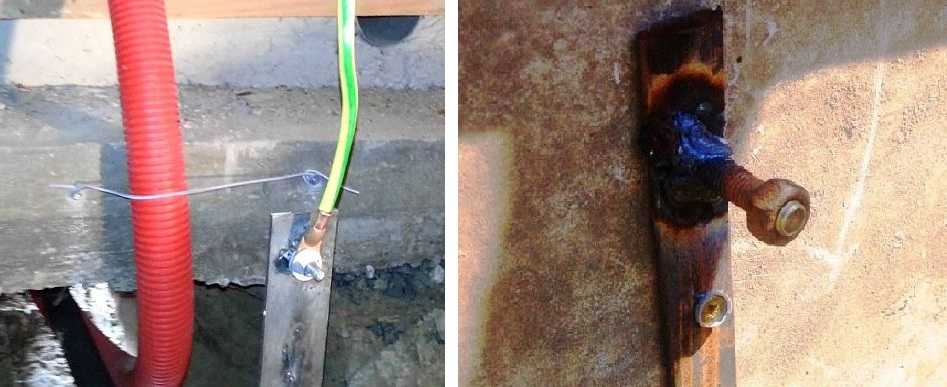
It is very unreasonable to use pipelines or other metal structures that are in the ground as a ground electrode. For some time, such grounding in a private house works. But over time, the pipe joints, due to electrochemical corrosion activated by leakage currents, oxidize and collapse, the grounding turns out to be inoperative, as well as the pipeline. Therefore, it is better not to use such types of ground electrodes.
How to do it right
First, let's deal with the shape of the ground electrode. The most popular is in the form of an equilateral triangle, at the tops of which pins are clogged. There is also a linear arrangement (the same three pieces, only in a line) and in the form of a contour - the pins are hammered around the house in increments of about 1 meter (for houses with an area of more than 100 sq. M). The pins are interconnected by metal strips - a metal bond.
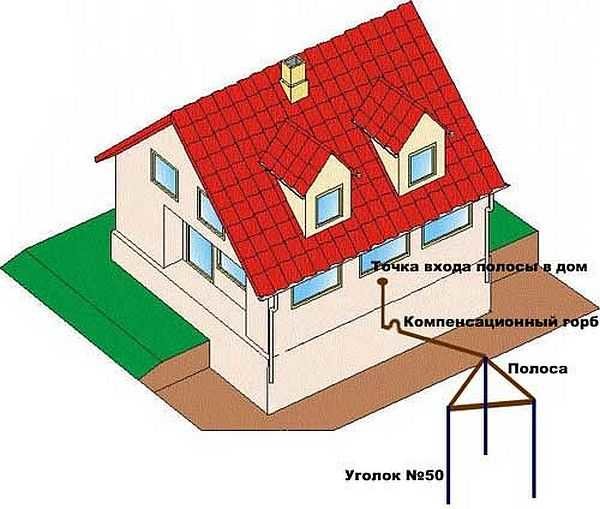
Procedure
From the edge of the house to the installation site, the pin should be at least 1.5 meters. In the selected area, they dig a trench in the form of an equilateral triangle with a side of 3 m. The depth of the trench is 70 cm, the width is 50-60 cm - so that it is convenient to cook. One of the peaks, usually located closer to the house, is connected to the house by a trench having a depth of at least 50 cm.
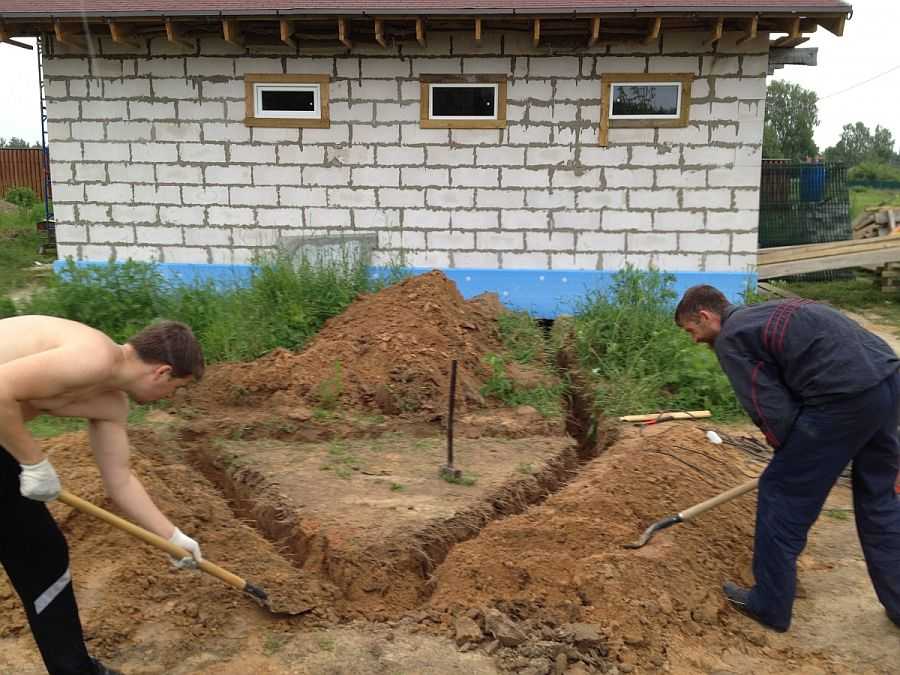
At the vertices of the triangle, pins are hammered (a round bar or a corner 3 m long). About 10 cm are left above the bottom of the pit. Please note that the ground electrode is not brought to the surface of the earth. It is located below the ground level by 50-60 cm.
A metal bond is welded to the protruding parts of the rods / corners - a strip of 40 * 4 mm. The created grounding conductor with the house is connected with a metal strip (40 * 4 mm) or a round conductor (section 10-16 mm 2). A strip with a metal triangle created is also welded. When everything is ready, the welding spots are cleaned of slag, coated with an anti-corrosion compound (not paint).

After checking the ground resistance (in the general case, it should not exceed 4 ohms), the trenches are covered with earth. There should be no large stones or construction debris in the soil, the earth is compacted in layers.
At the entrance to the house, a bolt is welded to the metal strip from the ground electrode, to which a copper conductor in insulation is attached (traditionally, the color of the ground wires is yellow with a green stripe) with a core cross section of at least 4 mm 2.
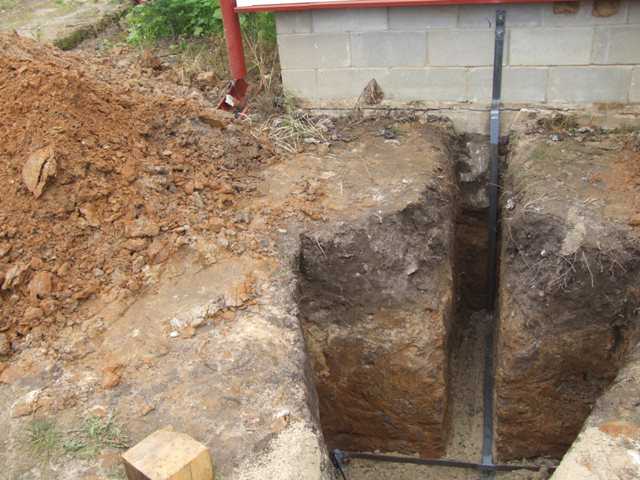
Ground outlet at the wall of the house with a bolt welded on the end
In the electrical panel, grounding is connected to a special bus. Moreover, only on a special platform, polished to a shine and lubricated with grease. From this bus, the "ground" is connected to each line that is bred around the house. Moreover, the wiring of the "ground" with a separate conductor according to the PUE is unacceptable - only as part of a common cable. This means that if your wiring is wired with two-wire wires, you will have to completely change it.
Why you can not make separate grounding
Redoing the wiring throughout the house, of course, is long and expensive, but if you want to operate modern electrical appliances and household appliances without any problems, this is necessary. Separate grounding of certain outlets is inefficient and even dangerous. And that's why. The presence of two or more such devices sooner or later leads to the output of the equipment included in these sockets. The thing is that the resistance of the contours depends on the condition of the soil in each particular place. In some situation, a potential difference occurs between two grounding devices, which leads to equipment failure or electrical injury.
Modular pin system
All devices described earlier - from hammered corners, pipes and rods - are called traditional. Their disadvantage is a large amount of land work and a large area that is required when installing a ground electrode system. This is because a certain area of contact of the pins with the ground is necessary, sufficient to ensure the normal "spreading" of the current. The need for welding can also cause complexity - it is impossible to connect the grounding elements in another way. But the advantage of this system is relatively low costs. If you do traditional grounding in a private house with your own hands, it will cost a maximum of $ 100. This is if you buy all the metal and pay for welding, and carry out the rest of the work yourself
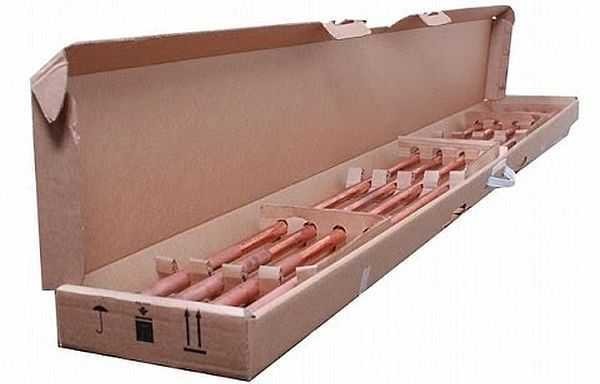
A few years ago, modular pin (pin) systems appeared. This is a set of pins that are hammered to a depth of up to 40 m. That is, a very long ground electrode is obtained, which goes to a depth. Fragments of the pin are connected to each other using special clamps, which not only fix them, but also provide a high-quality electrical connection.
The advantage of modular grounding is a small area and less work that is required. A small pit is required with sides of 60 * 60 cm and a depth of 70 cm, a trench connecting the ground electrode with the house. The pins are long and thin, it is not difficult to drive them into suitable soil. This is where we came to the main disadvantage: the depth is large, and if you meet, for example, a stone on the way, you will have to start over. And removing the rods is a problem. They are not welded, but whether the clamp will withstand or not is a question.
The second disadvantage is the high price. Together with the installation, such grounding will cost you $ 300-500. Self-installation is problematic, since it will not work to hammer these rods with a sledgehammer. We need a special pneumatic tool, which we learned to replace with a percussion hammer. It is also necessary to check the resistance after each clogged rod. But if you don't want to mess with welding and earthworks, a modular grounding pin is a good option.



